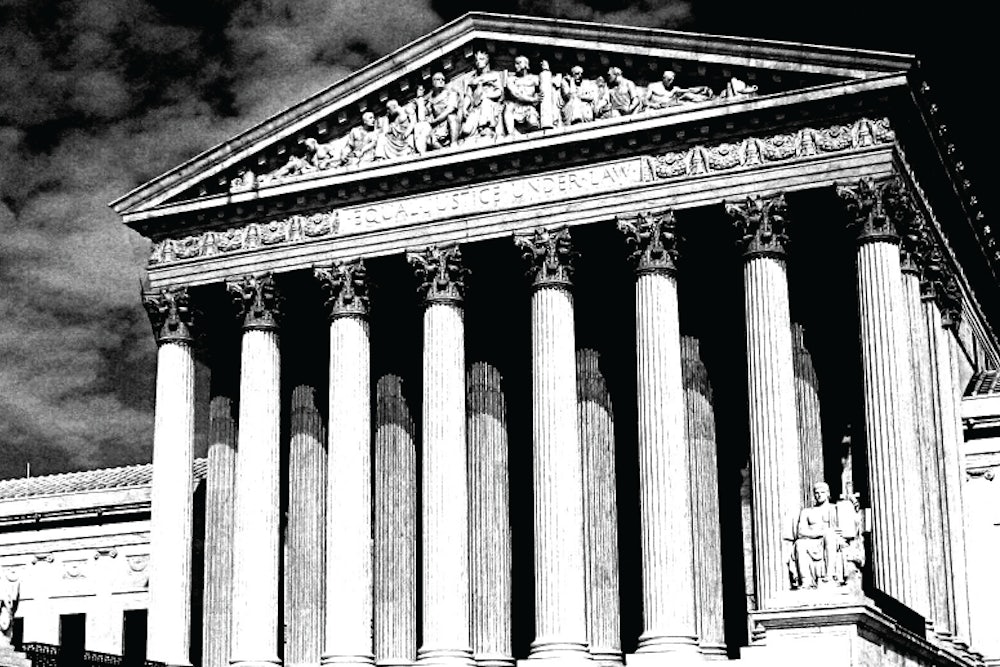Debates about the proper role of the judiciary dominated the Lochner era. Was the Supreme Court using its powers properly? Did its decisions reflect any real Constitutional principles?
It was taken for granted that the Supreme Court cast a skeptical eye on regulation of business, including key elements of the New Deal. However, Franklin D. Roosevelt’s proposal to pack the Court with friendly justices, and his massive reelection in 1936 on a pro-New Deal platform, heralded a rethinking. The Court-packing scheme invited skepticism not just from conservatives, but from liberals including New Republic writers, who worried that the concept could be turned against them in the future by the right. However, as the Lochner era came to an end, the urgent need to reshape the Court receded, and the debate fizzled.
♦♦♦
March 31, 1917: The Supreme Court’s Power
“It has become a commonplace that perhaps the most far-reaching effect of the present war will be an ever-increasing scope of governmental control over private business, and over the standards of life and labor. ...This whole program is imperiled as long as the Supreme Court retains its present power over social legislation... There are only two ways of avoiding it. Either the appointments to the Supreme Court must be frankly based on the political and social outlook of the nominee; or the Supreme Court must be shorn of its present power of upsetting social legislation on the ground that it is inconsistent with due process. Can it be doubted that the latter is the safer and sounder course?”
♦♦♦
June 20, 1928: That Living Constitution
“The stiffer legal minds of the Supreme Court either still describe industry to themselves in the terms of Adam Smith, or they possess a faith in the benevolence of modern business which we cannot share.... Freedom of contract and the due-process clause of the Fourteenth Amendment have again been made to serve the cause of reaction.... For those who are interested in such changes as are involved in the abolition of child labor, in the reconstruction of the coal industry, in a program of relief for farmers, in securing adequate social insurance, in the greater coordination of industrial affairs by national planning, there remains ,apparently, some hope - but only so much as can conceivably be clustered about the possibility of minorities being transformed into majorities by the passage of time or the prescience of Presidents.”
♦♦♦
July 31, 1935: Court Kills the A.A.A.
“It is ironical and unjust that what a large part of industry has power to do for itself by way of restricting output and maintaining prices, Congress has, under our judicially interpreted Constitution, no power to help the farmers to do. But in both cases the practice is anti-social and opposed to the best interests of farmers and workers alike. It would be much more to the point if Congress, to give parity to the farmers, could reduce industrial prices and enlarge industrial production. Any such attempt at control of industry, however, would also be unconstitutional under the Schechter and previous decisions. The courts forbid the government from doing anything important to regulate the national economy, whether it is bad or whether it is good. That is, they forbid it from doing anything that privately owned industry does not want done.”
♦♦♦
June 10, 1936: Liberty to Starve
“Anybody who henceforth proposes to do anything by law about hours and wages in general, either for women or for men (though there are still certain exceptions in which action is permitted), must, if he is not to mislead the public, at the same time say what he proposes to do about the Constitution or the Supreme Court or both. As matters stand, the Constitution makes the economic doctrine of laissez-faire the supreme law of the nation. We have a government that cannot govern one of the fundamental factors in the economic and social process. It cannot do so, no matter how many voters want it to do so, and no matter what good reasons for doing so may be held by those who give the matter careful study. Democracy is balked by the constitutional protection of the liberty of women to work for starvation wages, for wages below the value of the services rendered.”
♦♦♦
August 4, 1937: The Court Sees a New Light
“A year ago minimum-wage legislation, even for women, still rested under the ban of the Court, the national government was for the most part without authority over the employer-employee relation in the industrial field, and social security was at best highly suspect on constitutional grounds. Today the truth contradicts each one of these statements. More than that, the tone of the Court has altered vastly in a twelvemonth. Last spring, following the slaughter of the AAA and “the little NIRA,” the Chief Justice jauntily proclaimed in his American Law Institute address, “I have to announce that the Supreme Court still functions,” and at about the same time six of the nine Justices joined in the case of Jones v. the SEC in an opinion which sets an all-time high for judicial arrogance. These lapses from good sense and good taste would not today be repeated.”
♦♦♦
June 15, 1938: The Court Is Reformed”Some effective way or ways must be found of registering a national desire that the Court act differently at the present time... The nature of the specific means is less important than the pressure itself. The very fact that a series of reactionary decisions led to a strongly supported proposal to pack the Court will of itself, no matter what happens as a result of this bill, exert a potent influence on the Court in the future. The learned Justices are bound to be a little more careful not to clothe their private prejudices in the Constitution, or to veto in the name of that broad document measures that the nation has decided it needs.”
